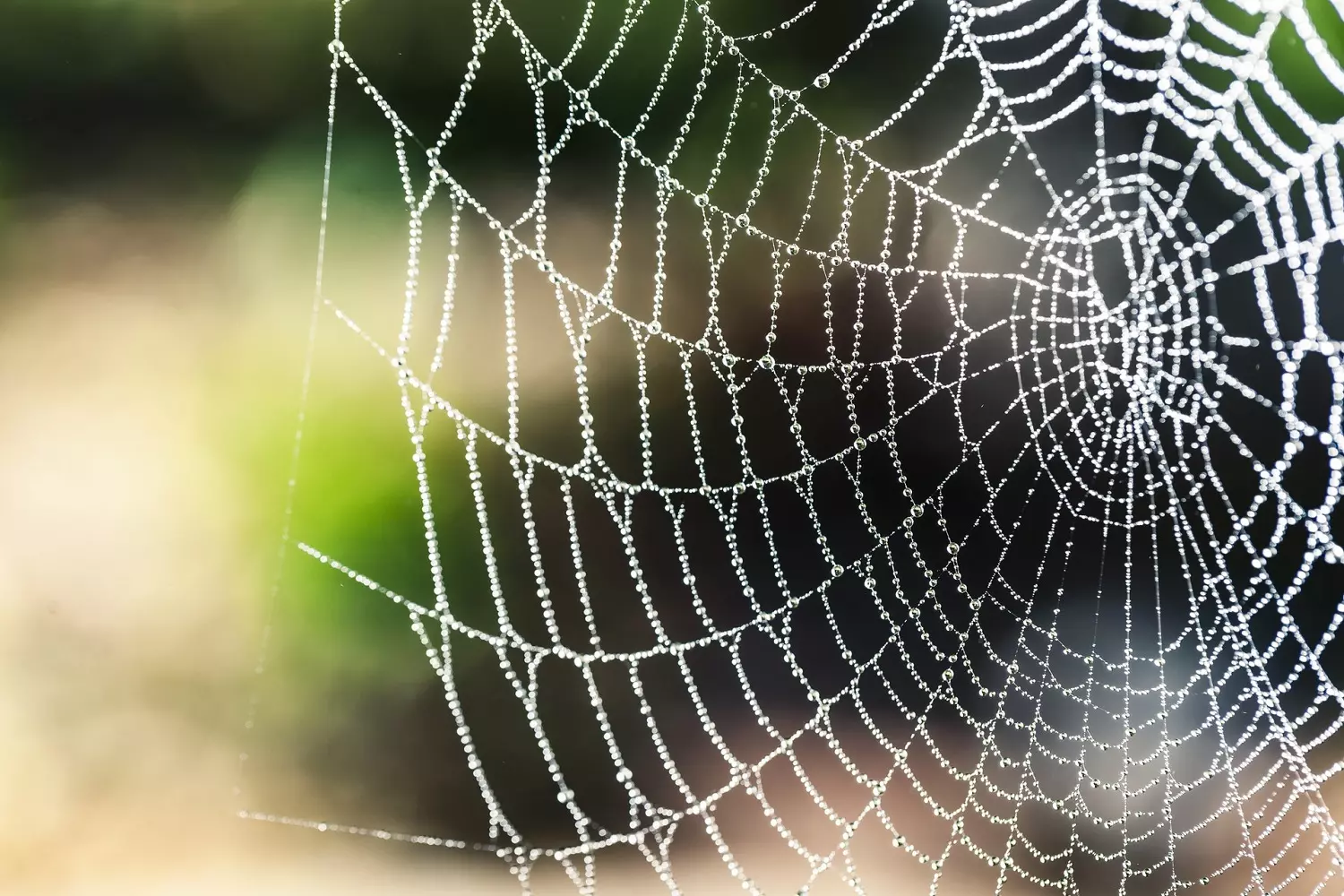Spider silk is strong yet flexible. Dragline silk is the fiber from which spiders make their web scaffolding. Scientists have estimated spider silk to be at least five times as strong as steel, twice as elastic as nylon, waterproof, and stretchable. Spider silk is an extremely resilient material and is, on a weight-to-weight basis, stronger than steel. It has been suggested that a pencil-thick strand of spider silk could stop a Boeing 747 in flight.
“The dragline silk spun by spiders exhibits unusual tensile strength and the energy required to break it can be higher than that of Kevlar,” says polymer scientist David Tirrell, who wrote a review for the journal Science. In his review, Tirrell describes the current research of several groups around the country trying to duplicate the properties of spider silk. To date, according to Tirrell, no one can replicate what the spider makes without even thinking.
How does the spider make the silk?
Spiders have special glands that produce a liquid protein series. When these proteins are mixed, the resulting mixture hardens — much like epoxy glue hardens when two liquids are mixed. The hardened mixture forms the silk strands. At least seven silk gland types have been recognized, but there is no known spider family that produces all seven types.
The spider silk is used for a lot of different applications:
- Constructing webs;
- enwrapping prey;
- producing egg sacs;
- jumping or dropping to escape;
- transferring semen to the female;
- marking draglines with pheromones;
- or sheltering structures into which the spider can retreat.
Additionally, spider silk conducts heat, which helps to keep the spider warm. Spider silk is also known to have antibiotic properties, which keeps the spider healthy.
Spider silk’s sticky nature is obvious. If you’ve ever had the displeasure of walking into a spider web and having silk plastered to your face, you know it’s a kind of sticky, clingy substance. A fly that flies full speed into such a trap doesn’t stand much of a chance of freeing itself. But in both cases, the unsuspecting victims come in full contact with the spider silk. The spider, on the other hand, doesn’t tumble willy-nilly about its web. A spider traverses its web in careful steps, tiptoeing delicately from thread to thread. Only the tips of each leg make contact with the silk. This minimizes the chances of the spider becoming ensnared in its own trap.
Spiders actually lay down two types of webbing: sticky and non-sticky. Some spiders do get stuck in their own sticky webs, mainly by accident. But most are able to bypass, on a movement-by movement basis, the sticky strands and follow the safe trail of non-sticky silk laid down first.
Web-building actually has several phases:
A spider begins by attaching a single silk strand horizontally between two supports, such as twigs or branches. It then builds an outside rim — almost like a bicycle wheel — and attaches spokes and a spiral from the center to the outside of the web. These parts of the web are all composed of non-sticky silk.
With this frame — the foundation for a decent web — firmly in place, the spider adds the sticky spiral strand pattern. This spiral is connected to the non-sticky spokes.
When a spider runs across from the center of the web to grab prey, it tends to go along a spoke, stepping on the bits that aren’t sticky. In essence, the spider simply tiptoes around the sticky glue deposited in globs on the web.
When a spider does accidentally step into one of these glue balls, it suffers no more inconvenience than a human stepping unto a wad of gum. When a fly slams into a spider’s web, however, it hits about fifty of the droplets simultaneously, enough to make it firmly stick.
More Than Just a Gooey Trap
Researchers have found that spider webs can actually reach out and grab insects. Scientists have long known that vibrations caused by wind, the stickiness of silk, and even the architecture of webs can help a spider land a meal. Now they can add electrostatic charge to that list of helpers.
Insects generate a static charge when they fly. Scientists conducted an experiment that showed that electrically charged insects can cause a spider web to bend toward the potential prey.
- The scientists collected a dozen garden spider webs.
- They also collected some insects: a handful of honeybees, bottle flies, fruit flies, and aphids. (Since the test insects were dead and couldn’t generate their own electrostatic energy, the researchers had to charge them artificially.)
- They dropped the charged insect bodies onto a web.
Time and time again, they saw the web lean toward the electrified insect. It was only a tiny deformation – just a couple of millimeters. But in the insect world, mere millimeters can often be the difference between flying free for the afternoon and becoming a spider’s mid-day snack.
Webs are recyclable!
When the orb-weaver takes apart an old web, it actually eats the silk components. The protein from the old silk is recycled from the spider’s digestive system to the silk glands to be made into a new web. Even if a spider misses a few meals, it can still go on spinning webs. This is thanks to the efficient reprocessing program that lets spiders conserve protein by eating old webs.
Scientists have radioactively labeled silk proteins. They then examined the new silk formed to determine how efficiently spiders reprocess the eaten silk. Remarkably, they’ve found spiders can consume and reuse silk proteins in as little as 30 minutes.
Spider webs can also be a source of hope and strength to the lost and endangered.
During World War II, a US marine was separated from his unit on a Pacific island. The fighting had been intense, and in the smoke and the crossfire, he had lost touch with his comrades.
Alone in the jungle, he could hear enemy soldiers coming in his direction. Scrambling for cover, he found his way up a high ridge to several small caves in the rock. Quickly he crawled inside one of the caves. Although safe for the moment, he realized that once the enemy soldiers looking for him swept up the ridge, they would quickly search all the caves and he would be killed.
As he waited, he prayed, “Lord, if it be your will, please protect me. Whatever your will, though, I love you and trust you. Amen.”
After praying, he lay quietly listening to the enemy begin to draw close. He thought, “Well, I guess the Lord isn’t going to help me out of this one.” Then he saw a spider begin to build a web over the front of his cave.
As he watched, listening to the enemy searching for him all the while, the spider layered strand after strand of web across the opening of the cave.
“Hah, he thought, “What I need is a brick wall and what the Lord has sent me is a spider web. God does have a sense of humor.”
As the enemy drew closer, the soldier watched from the darkness of his hideout and could see them searching one cave after another. As they came to his, he got ready to make his last stand. To his amazement, however, after glancing in the direction of his cave, they moved on. Suddenly, he realized that with the spider web over the entrance, his cave looked as if no one had entered for quite a while.
“Lord, forgive me,” prayed the young man. “I had forgotten that, in You, a spider’s web is stronger than a brick wall.”
We all face times of great trouble. When we do, it is easy to forget that God can work wonders in our lives — sometimes in the most surprising ways. In God’s hands, a spider’s amazing web can be spun into a safe refuge: a strong tower and a fortress for our defense. In the Master’s hands, even the seemingly insignificant in man’s eyes can be exceedingly significant in God’s plan.







